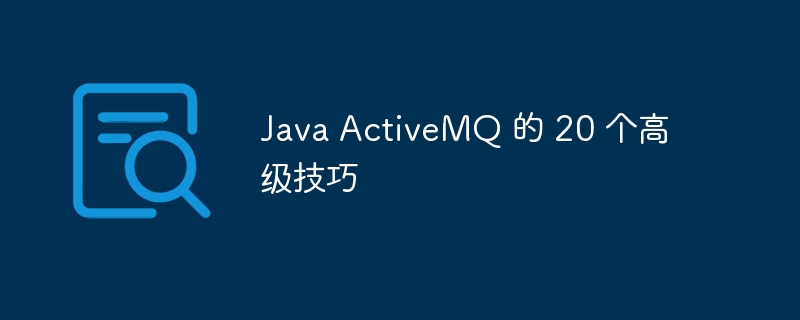Home >Java >javaTutorial >20 Advanced Tips for Java ActiveMQ
20 Advanced Tips for Java ActiveMQ
- WBOYWBOYWBOYWBOYWBOYWBOYWBOYWBOYWBOYWBOYWBOYWBOYWBforward
- 2024-02-20 21:51:071168browse

Java ActiveMQ is a powerful messaging middleware that provides developers with a wealth of advanced techniques that can help optimize system performance and improve the efficiency of message delivery. In this article, PHP editor Strawberry will share 20 advanced Java ActiveMQ tips to help developers make better use of this tool and improve development efficiency and system stability. From message filtering to cluster deployment, from performance tuning to transaction management, these tips will bring new inspiration and improvements to your projects.
- Use JMS Selectors to filter messages: Use JMS Selectors to filter incoming messages based on message properties and only process relevant messages.
- Create a custom message router: Extend the routing capabilities of ActiveMQ to send messages to specific destinations by writing a custom router.
- Configure polling load balancing: Evenly distribute incoming messages to multiple message consumers to improve processing capabilities.
2. Durability
- Enable persistent sessions: Ensures that even if the application or server fails, messages are stored persistently to avoid loss.
- Configure the Dead Letter Queue (DLQ): Move messages that fail to be processed to the DLQ for reprocessing or analysis.
- Use Journal storage: Improve the performance of persistent messages and reduce database overhead.
3. Transaction
- Use XA transactions: Coordinate transactions for multiple resources in a distributed system to ensure consistency in message processing.
- Configure transaction batch processing: Improve the throughput of transaction processing and process multiple messages at one time.
- Enable reliable transmission: Ensures that messages are not lost or corrupted during network transmission.
4. Configuration
- Adjust the message size limit: Adjust the maximum size of the message according to the actual load to prevent excessive memory usage.
- Configure connector timeout: Set the connector timeout value to avoid wasting resources due to long-term unused connections.
- Enable cached reading and writing: Optimize the performance of message reading and writing, and reduce the number of database accesses.
5. Monitoring
- Use JMX monitoring: Monitor the running status of ActiveMQ in real time through the JMX interface, including message queue length, message processing rate, etc.
- Configure alerts and notifications: Set alert thresholds to trigger notifications when abnormal conditions occur.
- Use Graphite or Prometheus: Export ActiveMQ metrics to a monitoring system such as Graphite or prometheus for long-term analysis.
6. Security
- Configure SSL: Encrypt ActiveMQ connections to protect messages from eavesdropping and tampering.
- Enable authorization: Control access to ActiveMQ resources and prevent unauthorized user operations.
- Use Kerberos authentication: Provide single sign-on function to simplify user management.
7. Cluster
- Create an ActiveMQ cluster: Group ActiveMQ instances to form a cluster to improve high availability and scalability.
- Configure failover: Set up a failover mechanism in the cluster to ensure that message processing is not interrupted when a failure occurs.
- Use distributed cache: Cache frequently accessed data in distributed cache to reduce the number of database accesses.
- Use ActiveMQ Web Console:
- Manage and monitor ActiveMQ through the WEB interface to simplify operations. Integrate third-party libraries:
- Extend ActiveMQ functionality, such as using Apache Camel to integrate other messaging protocols. Writing custom plugins:
- Create custom plugins to extend the core functionality of ActiveMQ.
10. Advanced Example
The above is the detailed content of 20 Advanced Tips for Java ActiveMQ. For more information, please follow other related articles on the PHP Chinese website!

